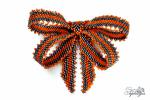
ещё информация
Necklaces
Necklaces of kangaroo sinew, grass cord covered with ochre, strips of animal fur and strings of shells were worn by both Tasmanian Aboriginal men and women for countless generations.
Shell necklace (Courtesy TMAG)
Perhaps the most striking and unique, is the tradition of shell necklaces made from the pearlescent kelp shell (Phasianotrochus irisodontes) known as the ‘maireener’.
Traditionally, the women made tiny holes in the shells by using a sharp object such as a bone point or eye tooth of a kangaroo and strung them on animal sinew or twine. These small but brightly coloured maireener shells are still treasured by the Community today, and the tradition of shell stringing continues to be a highly regarded cultural practice which has developed to include a wide range of shells strung with needle and thread.
The discovery of a number of pierced shells dating back approximately 1,800 years during the excavation of an Aboriginal site on Tasmania’s north west coast is the earliest known connection to these intricate and beautiful necklaces. These shells were highly prized and often traded between tribal groups and with visitors to lutruwita (Tasmania). In 1802 explorers with the French expedition led by Baudin observed the tradition of shell necklace making, with botanist Leschenault noting their importance and use in ritual exchange:
Several of them [the Aborigines] crossed the strait [from Bruny Island]...On arrival, [the chief] gave me the necklace he was wearing, which was made of shells of glistening mother-of-pearl, strung on a small cord made of bark and grass. [H]e asked in exchange a necklace of glass beads, which I immediately gave him. (Leschenault 1802)
Today only a small number of women still painstakingly collect, clean, polish and string a variety of shells found on the Furneaux islands and mainland Tasmania. These women have carried on the tradition, renewing and creating an interest for younger members of the Aboriginal community, whilst also receiving both national and international recognition for their craft.
Text courtesy of the Tasmanian Museum and Art Gallery
__________________
C Днём Победы!

|